What Documents Do You Need to Sell Your House in California?
Selling a house in California requires more than just finding a buyer. It involves gathering and providing specific documentation to ensure a smooth and legally sound transaction. Whether you are working with a real estate agent or selling by owner, understanding the key documents required at each stage of the sale is crucial.
To sell a house in California, you need documents such as ownership verification (such as the Grant Deed), mandatory disclosures (like the TDS and Natural Hazard Disclosure), property records (e.g., property tax bills), financial statements, purchase agreements, and closing documents. These documents ensure that all legal requirements are met, protecting both you and the buyer throughout the process.
The right paperwork also helps prevent delays and complications in the sale. For example, proper disclosures about the condition of the property help build trust with the buyer. Financial documents, such as the mortgage payoff statement, ensure the transaction is clear of any outstanding debts. Having everything in order makes the selling process quicker and easier for everyone involved.

1. Ownership & Title Documents
To verify ownership and ensure a smooth title transfer, you will need to provide documents like the Grant Deed, Preliminary Change of Ownership Report (PCOR), and HOA documents if applicable. These documents are crucial for confirming legal ownership, ensuring the title transfer is clear, and informing the buyer about any community rules or fees associated with the property.
Grant Deed or Title Report
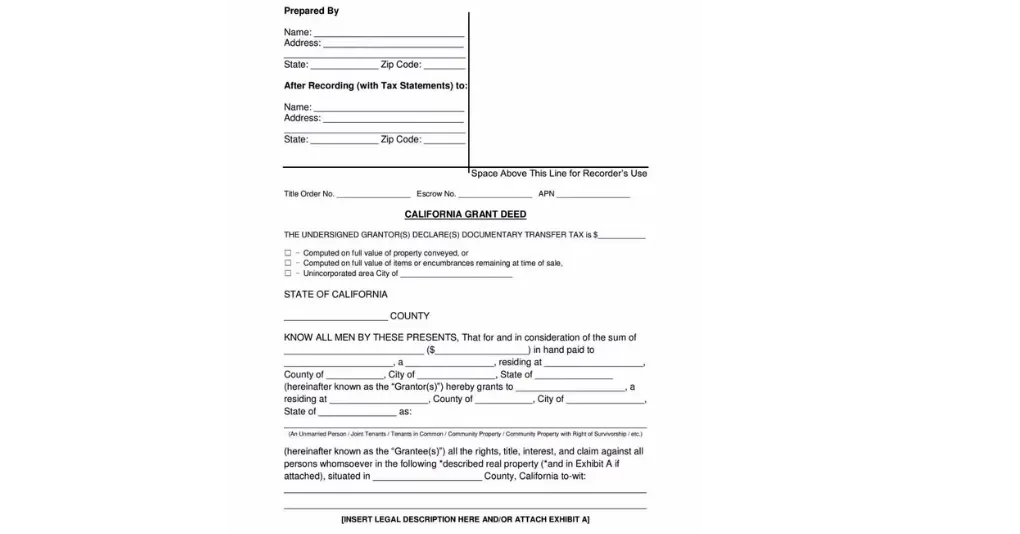
The Grant Deed is a legal document that proves the seller’s ownership of the property and is used to transfer the title to the buyer. It guarantees that the seller has the legal right to sell and that the property is free from any undisclosed claims or encumbrances. In California, the Grant Deed is essential for ensuring that ownership is transferred clearly and legally.
Alongside this, the Preliminary Title Report, issued by a title company, verifies that the property’s title is free of any legal claims, liens, or disputes that could affect the sale. This report provides crucial information about the property’s title status, ensuring that the transaction can proceed smoothly without any unexpected legal complications.
Preliminary Change of Ownership Report (PCOR)
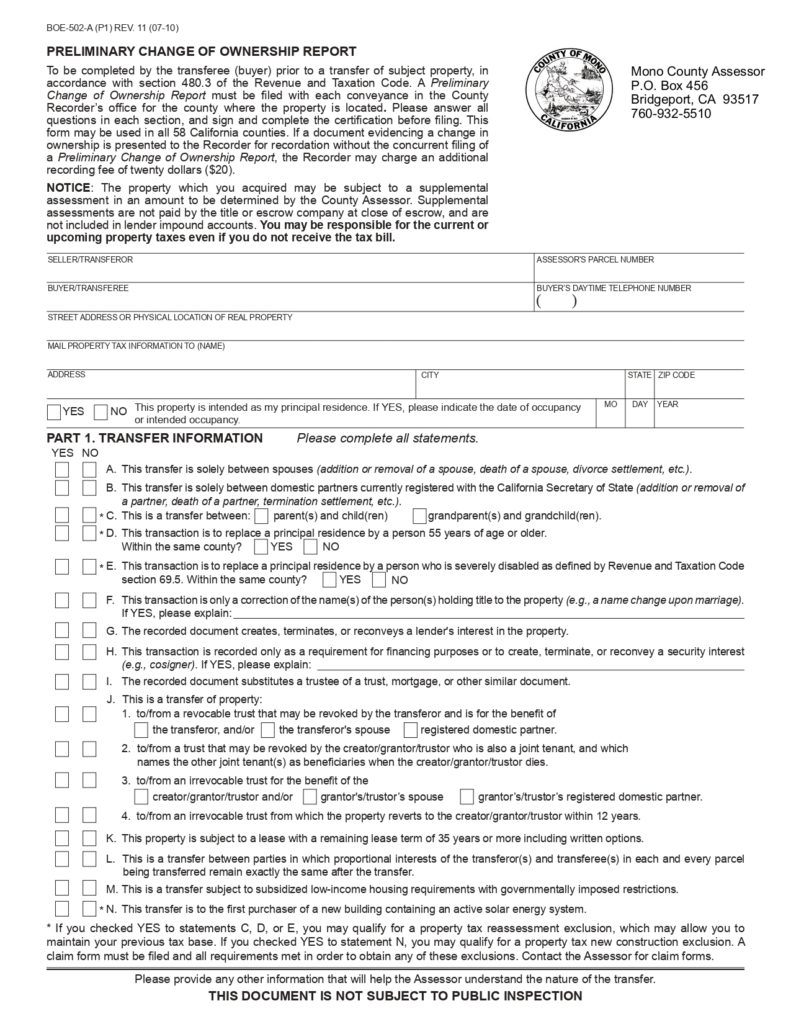
The Preliminary Change of Ownership Report (PCOR) is a legal requirement that prevents property tax reassessment when transferring ownership. This document must be filed with the county assessor’s office under Proposition 13 and includes key information, such as the Assessor’s Parcel Number (APN), property information, transfer nature, transfer price, and any exemptions from reassessment, such as transfers between spouses or parents and children.
Failure to file the PCOR can lead to a tax reassessment at a higher rate, potentially increasing the buyer’s property tax obligations after the sale. By submitting the PCOR, the seller ensures the proper tax status is maintained, avoiding any future disputes over tax liabilities.
Homeowners Association (HOA) Documents (If Applicable)
If the property is part of a Homeowners Association (HOA), you must provide documents such as the Covenants, Conditions & Restrictions (CC&Rs), HOA bylaws, and financial statements to the buyer. These documents outline the community’s rules, fees, and financial health, ensuring the buyer understands their obligations and the overall condition of the HOA.
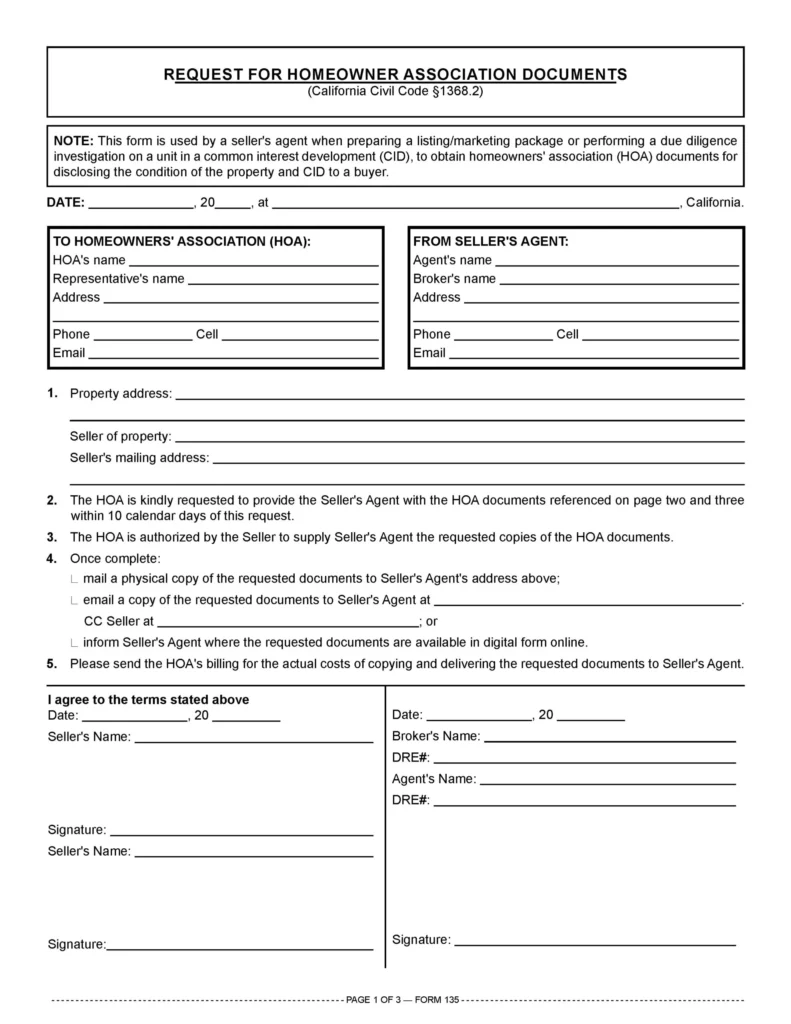
California law mandates that these documents be disclosed to the buyer to ensure transparency about ongoing fees and community regulations. Providing accurate and complete HOA documents helps avoid future conflicts and ensures the sale complies with legal requirements.
Ownership & Title Document Requirements
| Document Name | Required By Law | Applies To | Provided By | Notes |
| Grant Deed | Yes | All Sales | Seller | Must be recorded during title transfer |
| Preliminary Change of Ownership Report | Yes | All Sales | Seller | Filed with County Assessor to prevent tax reassessment (Prop 13) |
| HOA Documents (CC&Rs, Bylaws, etc.) | Yes (if applicable) | HOA Properties Only | Seller / HOA | Must disclose rules, fees, and financials |
| Preliminary Title Report | No | All Sales | Title Company | Verifies clean title, liens, or encumbrances |
| Quitclaim Deed | No | If Title Issues Exist | Seller | Used to resolve ownership discrepancies |
| Trust Documents | Yes (if in Trust) | Trust-held Property | Seller / Trustee | Proves seller has authority to sell property |
| Death Certificate | Yes (if inherited) | Inherited Property | Seller / Estate Executor | Required to transfer ownership in probate sales |
| Power of Attorney (Notarized) | Yes (if used) | If Seller Absent | Seller | Must be notarized to be valid |
2. Mandatory California Disclosures
In California, sellers must provide key disclosures, including the Transfer Disclosure Statement (TDS), Natural Hazard Disclosure (NHD), and Seller Property Questionnaire (SPQ). These documents outline the property’s condition, any natural hazards, and other important factors that could affect the buyer’s decision. Failing to provide these disclosures can lead to delays or legal issues, making them essential for a smooth transaction.
Transfer Disclosure Statement (TDS – Form RE 11)
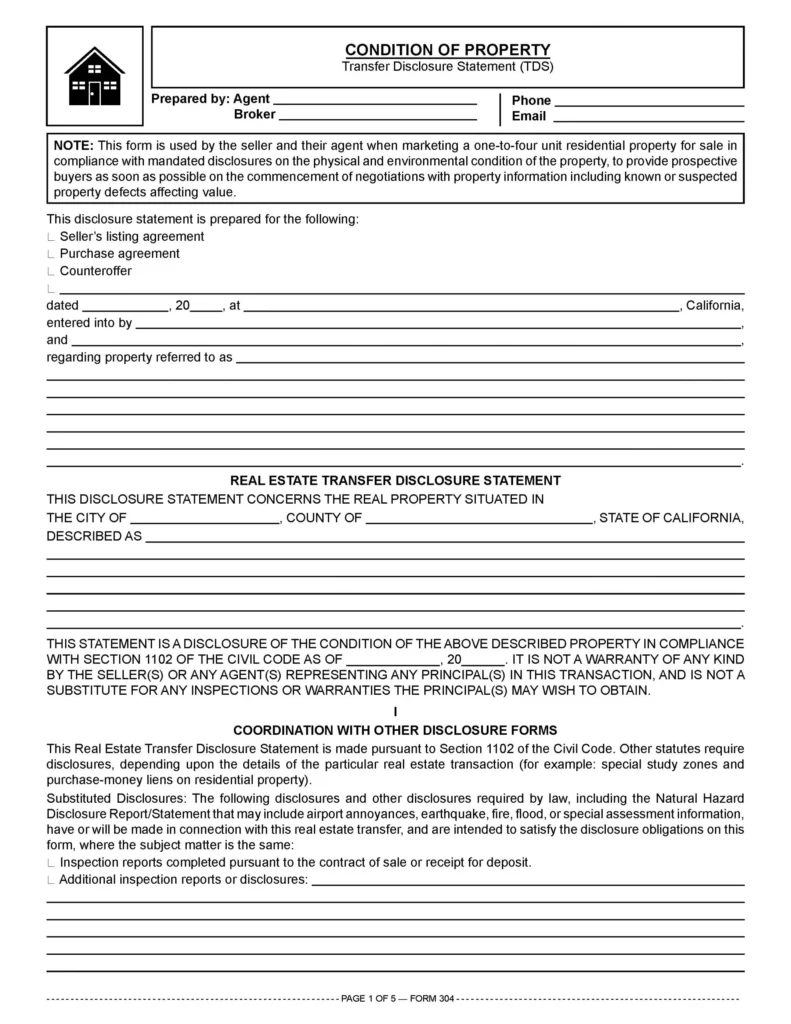
The Transfer Disclosure Statement (TDS) is a legal requirement in California for sellers to disclose any known defects or issues with the property. This form ensures transparency and provides a detailed account of the condition of the property, helping the buyer make an informed decision. The TDS must cover the following aspects:
- Structural issues (e.g., foundation, roof, or walls)
- Plumbing and electrical systems (e.g., leaks or faulty wiring)
- Environmental hazards (e.g., lead-based paint, asbestos, or radon)
- Past repairs or modifications (e.g., renovations)
- Neighborhood issues (e.g., noise, traffic congestion, or boundary disputes)
- Other material facts that a reasonable buyer should be aware of
Failure to provide an accurate TDS can lead to legal complications, including lawsuits, rescission of the sale, or reputational damage.
Natural Hazard Disclosure (NHD) Report
The Natural Hazard Disclosure (NHD) is a mandatory document in California, required by the 1988 Natural Hazard Disclosure Act. It informs the buyer about potential natural risks that could affect the property. The report must disclose whether the property is located in areas prone to the following hazards:
- Floods
- Earthquake fault lines
- Wildfires
- Seismic hazard zones
- Risks from a dam breach
The NHD typically costs home sellers between $50 and $150, depending on the property’s location and the length of the report. Failure to provide this disclosure can lead to legal consequences, as buyers may claim they were not adequately informed of these risks.
Local Option Disclosures (If Applicable)
In certain California cities or counties, additional disclosures may be required under local option disclosures. These can include information related to Megan’s Law, which mandates that sellers inform buyers if the property is within a certain distance of a registered sex offender’s residence, or local ordinances that affect the property, such as zoning laws or safety codes. Sellers must be aware of the specific requirements in their local jurisdiction to comply with these regulations.
Neglecting to provide these disclosures could lead to delays, legal disputes, or complications in finalizing the sale. Sellers need to understand and fulfill these local requirements to ensure a smooth transaction.
Lead-Based Paint Disclosure (For Pre-1978 Homes)
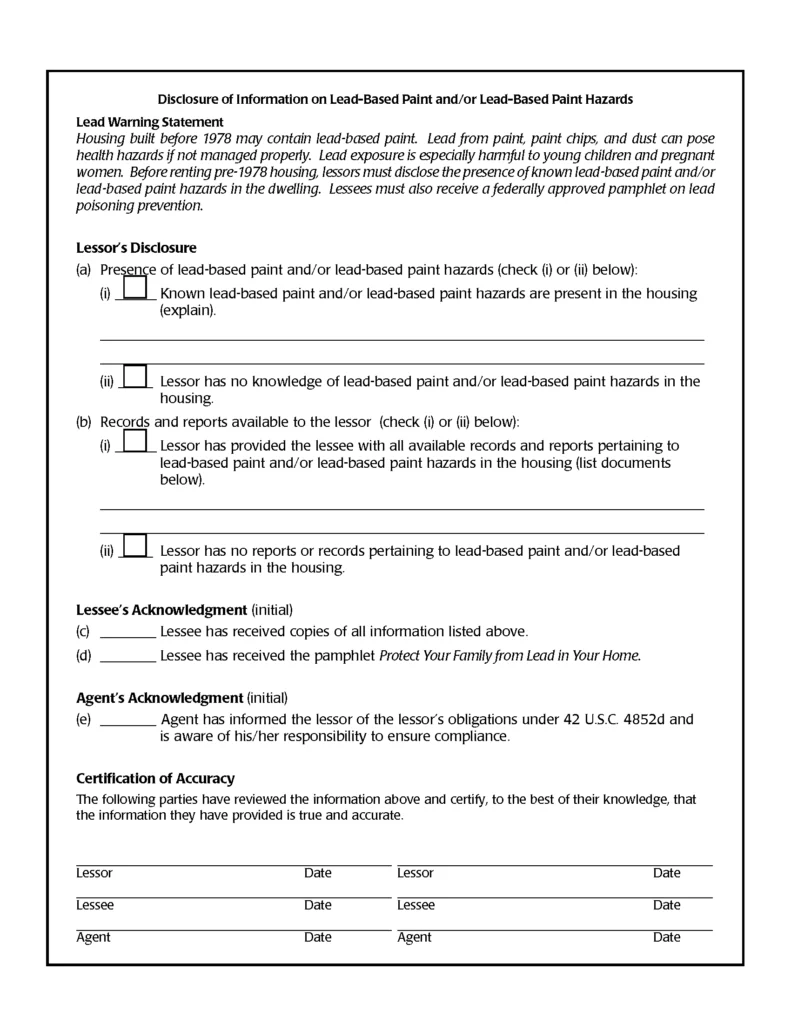
For homes built before 1978, sellers must provide a Lead-Based Paint Disclosure to inform buyers of potential lead risks. This includes giving the EPA pamphlet titled ‘Protect Your Family from Lead in Your Home,’ disclosing any known lead hazards, and providing previous inspection reports. The lead disclosure form must also be included in the contract. Sellers are typically required to hold onto these records for three years from the date the lease or sale begins.
However, this requirement does not apply to zero-bedroom units, short-term leases, housing for the elderly, homes tested and found lead-free, foreclosure sales, or homes built after 1977.
Seller Property Questionnaire (SPQ – Form RE 32)
The Seller Property Questionnaire (SPQ) is a supplemental disclosure form that provides more detailed information about the property’s condition, history, and any potential issues not covered in the Transfer Disclosure Statement (TDS).
While not required by law, the SPQ is highly recommended to give buyers a full understanding of the property. This form asks questions about the property’s history, including issues with the foundation, plumbing, and any past repairs or neighborhood concerns. Providing an accurate SPQ can help prevent future disputes, as it offers greater transparency and can be used as evidence if any post-sale issues arise.
Earthquake Safety Guide (C.A.R. Form EHD)
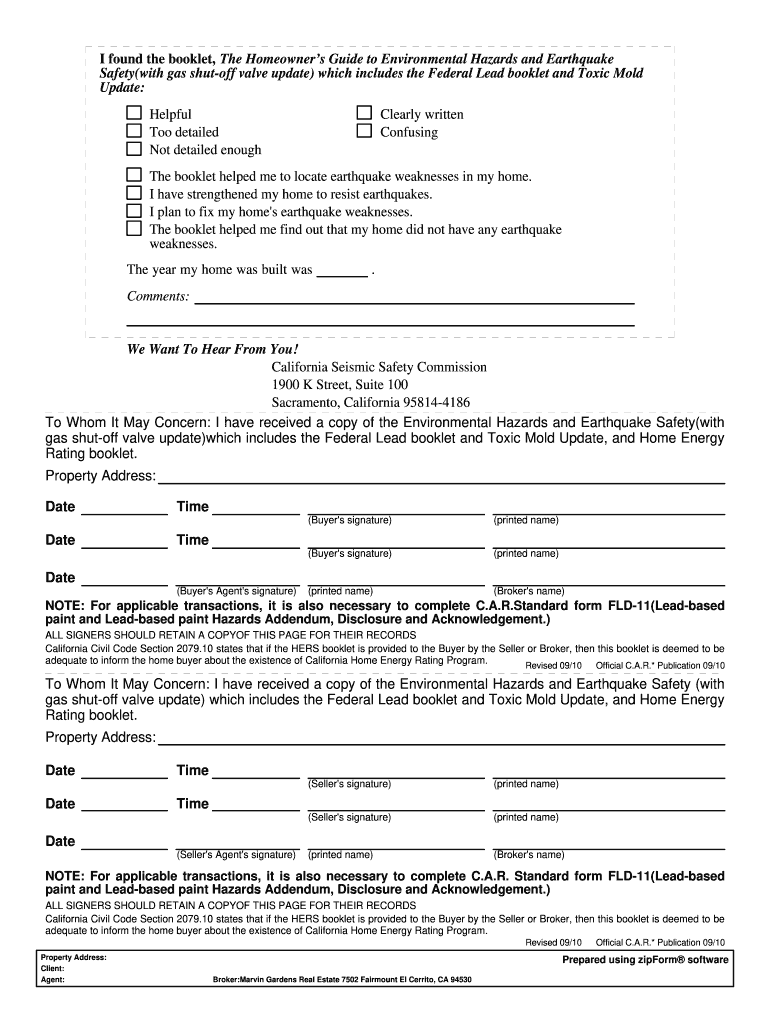
The Earthquake Safety Guide (C.A.R. Form EHD) is required for homes located in California’s earthquake hazard zones. This document provides essential information about the seismic risks in the area and outlines safety measures, such as the importance of retrofitting the home to reduce earthquake damage.
Sellers must provide this guide to buyers to ensure they understand the property’s potential vulnerability to earthquakes and any necessary precautions. Failure to provide the guide can result in legal consequences, as California law mandates informing buyers of such risks before finalizing the sale.
Smoke and Carbon Monoxide Detector Compliance
Following California Health and Safety Code Sections 13113.7, 13113.8, and 18029.6, sellers must ensure that smoke and carbon monoxide detectors are properly installed and functional before selling a home. The requirements include:
- Smoke detectors must be installed in every sleeping area and hallway.
- Carbon monoxide detectors must be installed outside sleeping areas and on every level of the home, including the basement, if there are fossil fuel-burning appliances, fireplaces, or an attached garage.
The seller is responsible for making sure these detectors are operational and compliant. Non-compliance can delay the sale, as the detectors must be tested monthly, and batteries or detectors replaced as needed.
Water Heater Bracing Compliance
Under California Law (Health and Safety Code §19211), all new and existing residential water heaters must be braced, anchored, or strapped to prevent movement during an earthquake. This applies to water heaters up to 120 gallons, with pre-engineered strapping kits available. Some local ordinances may have stricter requirements, so sellers should verify with local authorities. Sellers must provide written certification confirming compliance, ensuring water heaters are secured by the close of escrow. Non-compliance can cause delays or fines, as there are no exceptions to this law.
Mandatory California Disclosures Documents
| Document Name | Required By Law | Applies To | Provided By | Notes |
| Transfer Disclosure Statement (TDS) | Yes | All Sales | Seller | Discloses known property defects and conditions |
| Natural Hazard Disclosure (NHD) | Yes | All Sales | Seller / Disclosure Co. | Discloses flood, fire, seismic, and other hazards |
| Seller Property Questionnaire (SPQ) | No (Strongly Advised) | All Sales | Seller | Adds detail beyond the TDS; prevents post-sale disputes |
| Lead-Based Paint Disclosure | Yes | Homes Built Pre-1978 | Seller | Includes EPA pamphlet + prior reports |
| Earthquake Safety Guide (Form EHD) | Yes (in hazard zones) | Quake Zones Only | Seller | Required for homes in earthquake-prone areas |
| Local Option Disclosures | Yes (if applicable) | City/County Specific | Seller | May include zoning, Megan’s Law, local codes |
| Smoke/CO Detector Compliance | Yes | All Homes | Seller | Devices must be installed/tested per CA Health & Safety Code |
| Water Heater Bracing Certification | Yes | All Homes | Seller | Must be braced per CA Code §19211 before close of escrow |
3.Property Information & Records
When selling a home in California, you must provide key property records, including property tax information, utility bills, home warranty details (if applicable), and permits for any significant work. These documents help buyers understand the property’s financial obligations, average utility costs, and the legality of any major renovations. Ensuring these records are complete and accurate is crucial for a smooth, transparent transaction.
Property Tax Information
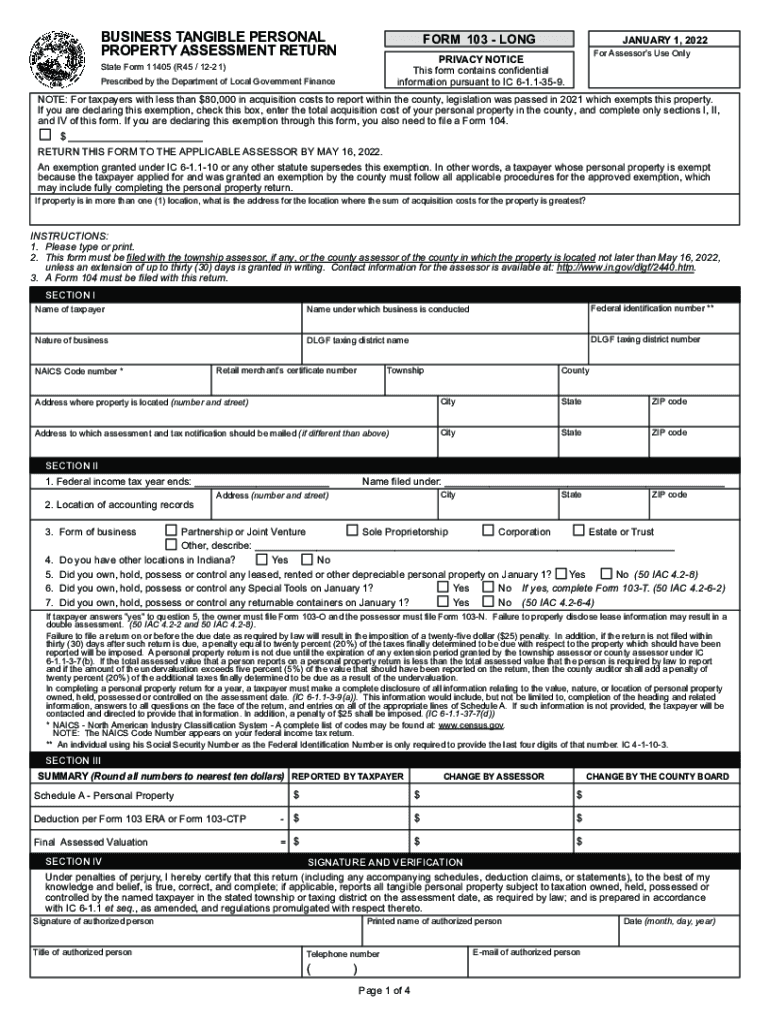
You must provide key property tax information, including the most recent property tax bill and the Assessor’s Parcel Number (APN), when selling a house in California. These details help the buyer understand any outstanding tax obligations on the property.
Additionally, Proposition 19 allows homeowners who are over 55, disabled, or impacted by wildfires or natural disasters to transfer their lower-assessed property value to a newly purchased home, up to three times (or once per disaster). It is also important to note that local governments may charge a fee, typically 55 cents per $500 of property value or 0.11%, depending on the jurisdiction.
Home Warranty Information (If Offering)
If offering a home warranty, sellers must provide the buyer with details about the coverage. This typically includes protection for major systems and appliances, such as HVAC, plumbing, and electrical systems. The warranty’s terms, including coverage length, exclusions, and service fees, should be disclosed.
While not required by law, offering a home warranty can be beneficial for both parties, providing the buyer peace of mind and potentially reducing the cost of future repairs. Transparency in these details helps avoid disputes later.
Utility Bills (Optional, but Helpful)
Providing utility bills helps the buyer understand the ongoing costs of living in the property, including electricity, water, gas, and waste management. Although not required by law, sharing recent utility bills offers transparency, allowing the buyer to estimate monthly expenses. This helps the buyer evaluate the affordability of the home and prevents unexpected costs after the sale. Offering these bills ensures the buyer is well-informed, contributing to a smoother transaction process.
Permits & Records
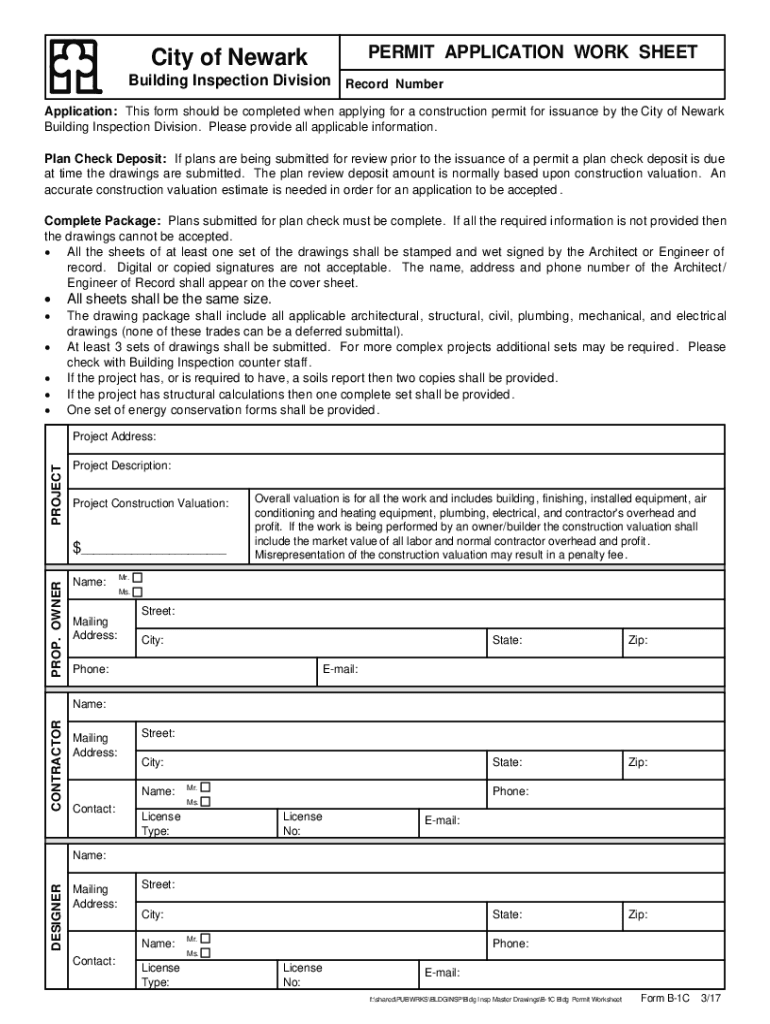
Sellers must provide permits and records for any major renovations or construction work done on the property. For example, if the seller renovated the kitchen or added a deck, the appropriate permits must be provided to confirm that the work met local building codes. These records show the buyer that the work was legally approved and complies with safety standards. Providing these documents helps avoid future disputes, ensuring that both parties are clear about the property’s history and legal compliance.
4. Loan Payoff & Financial
Sellers in California must provide important financial documents, including the Mortgage Payoff Statement and HELOC details. The Mortgage Payoff Statement confirms the remaining balance of the mortgage, while HELOC details ensure that any outstanding balances on a home equity line of credit are properly addressed before closing. These documents are necessary to ensure a clean financial transfer during the sale.
Mortgage Payoff Statement(s)

The Mortgage Payoff Statement is a document from your lender that outlines the total amount required to pay off your mortgage, including the remaining principal, interest, and any fees.
For example, if you owe $200,000 on the mortgage with $5,000 in accrued fees and interest, the payoff statement will show the total amount due to clear the loan. This statement is crucial for the escrow process, ensuring that all debts are settled before the property is transferred to the buyer. Sellers must obtain this statement from their lender to avoid any financial complications during closing.
Home Equity Line of Credit (HELOC) Info
If you have a Home Equity Line of Credit (HELOC), you must provide the current outstanding balance to the buyer. This is crucial to ensure that any liens attached to the property are paid off before closing.
For example, if you have a $50,000 HELOC balance, it must be disclosed and cleared as part of the sale process. The HELOC information includes details of the loan balance, interest rate, and any fees, which are necessary to ensure a smooth financial transaction and clear title transfer.
| Document Name | Required By Law | Applies To | Provided By | Notes |
| Property Tax Statement | Yes | All Sales | Seller | Recent tax bill + Assessor’s Parcel Number (APN) |
| Mortgage Payoff Statement | Yes | If Mortgage Exists | Lender / Seller | Required to close loan and clear lien |
| HELOC Balance & Payoff Info | Yes | If HELOC Exists | Lender / Seller | Must be cleared before closing |
| 1099-S IRS Form | Yes | All Sales | Title/Settlement Company | Reports real estate transaction to IRS |
5. The Purchase Agreement & Closing Docs
The Purchase Agreement and closing documents are key to finalizing the sale of a home in California. The Purchase Agreement outlines the sale price, contingencies, and other negotiated terms, while closing documents, including the Closing Statement and Deed of Reconveyance, settle the financial details and transfer ownership. Ensuring these documents are accurate and complete is critical for a smooth closing and to avoid potential legal or financial complications.
Listing Agreement
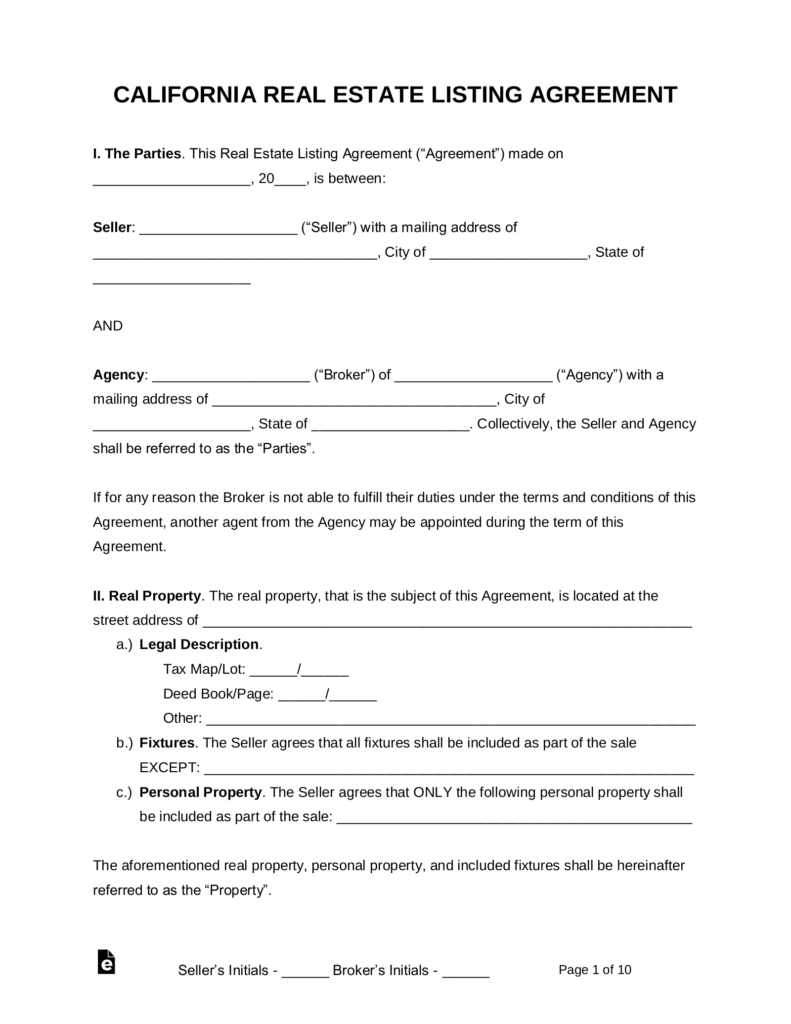
The Listing Agreement is a contract between the seller and the real estate agent, detailing the terms of representation and sale. It typically includes:
- The sale price and commission structure.
- The listing duration and any renewal terms.
- The agent’s responsibility to market and negotiate the sale.
- Any exclusivity clauses or special conditions.
This agreement is essential for formally engaging an agent and setting clear expectations for the sale process.
Purchase Agreement & Counter-Offers
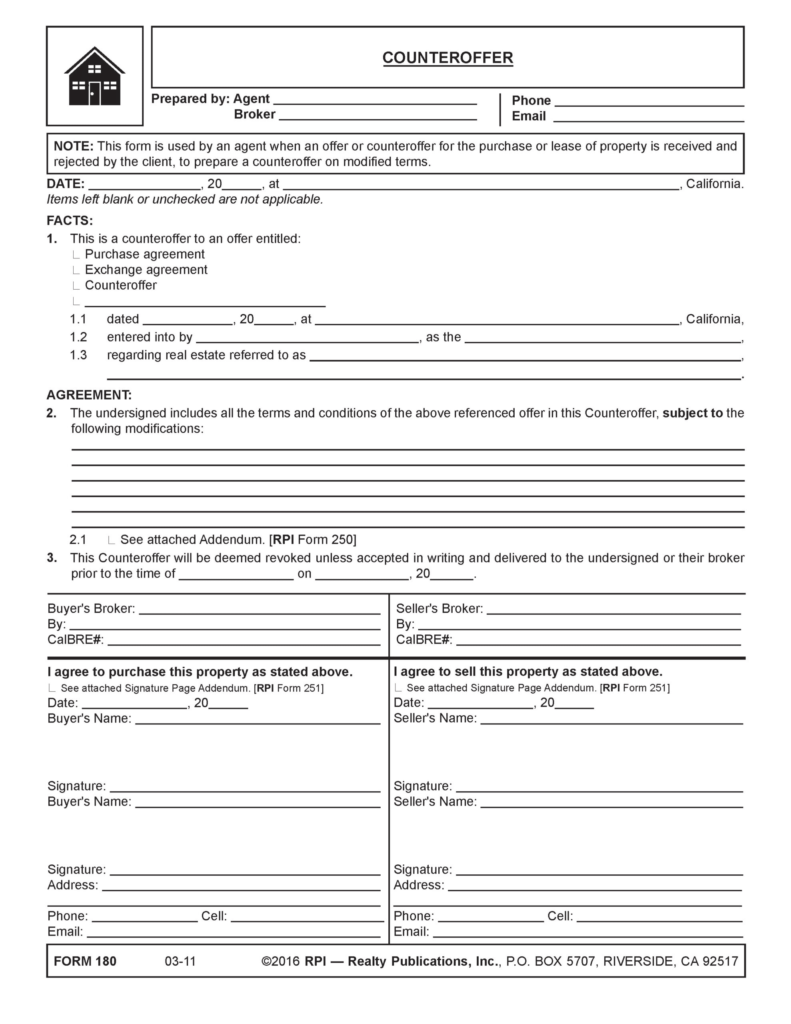
The Purchase Agreement is the formal contract between the buyer and seller that outlines the terms of the sale, including the price, contingencies, and closing date. If the buyer makes changes to the initial offer, such as adjusting the price or conditions, the counteroffer process begins. This allows both parties to negotiate until an agreement is reached.
Key elements in the Purchase Agreement:
- Sale price and payment terms.
- Contingencies such as financing or home inspection.
- Closing date and any specific conditions.
- Counter-offer details if applicable.
Closing Statement (ALTA/Closing Disclosure)
The Closing Statement (or ALTA/Closing Disclosure) is a detailed document outlining all financial aspects of the transaction, including the sale price, closing costs, agent commissions, taxes, and any other fees. It provides a breakdown of funds being disbursed and the net amount the seller will receive. Only the lender can provide the Closing Disclosure to the buyer, and it must be delivered three days before closing.
There are four versions of the ALTA Settlement Statement:
- ALTA Settlement Statement Borrower-Buyer
- ALTA Settlement Statement Cash
- ALTA Settlement Statement Combined
- ALTA Settlement Statement Seller
Deed of Reconveyance
The Deed of Reconveyance is a legal document that releases the lien on the property once the mortgage is fully paid off. It confirms that the lender’s claim on the property has been satisfied and clears the title for the buyer. The deed typically includes:
- The name and address of the homeowner/mortgage borrower.
- The name of the lender or trustee.
- A legal description of the property and parcel number.
- Proof that the borrower has fulfilled their mortgage obligations.
- Signatures of the involved parties and a notary stamp.
In California, if the lender fails to provide the deed, a title company can prepare and register it within 72 days of repayment. The borrower must submit the deed to the county recording office to finalize the process.
1099-S Form
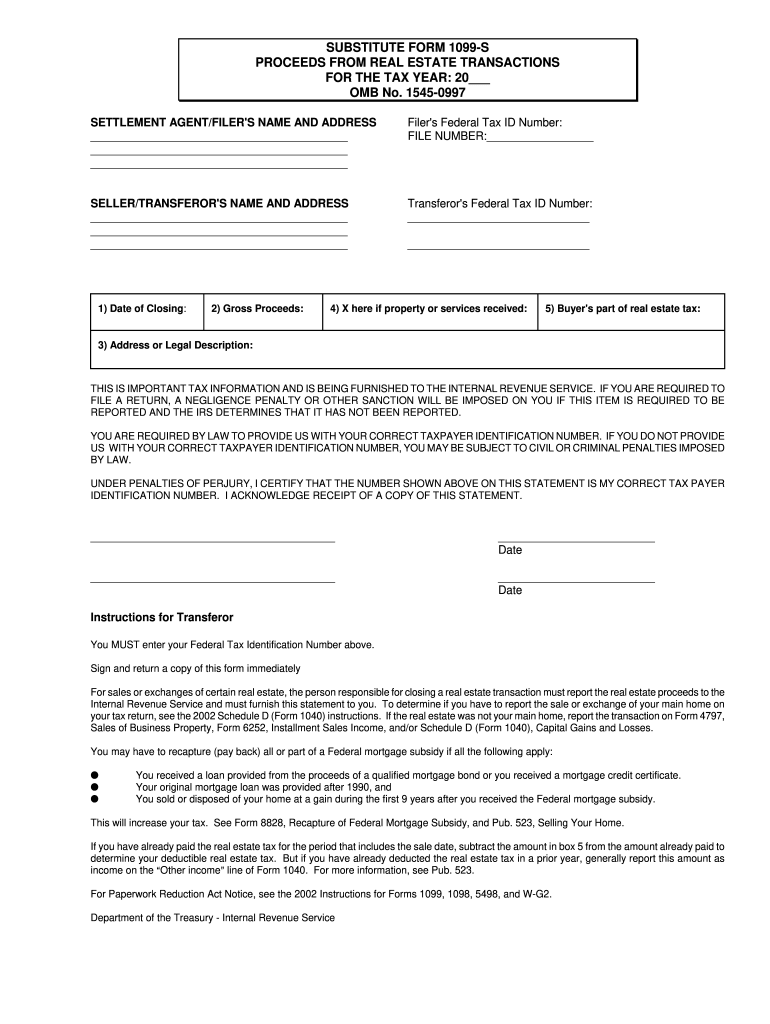
The 1099-S Form is used to report the sale of real estate to the IRS. It provides details about the sale, including the sale price, the date of sale, and the seller’s information. For example, if you sell your home for $300,000, the 1099-S will report this sale price to the IRS. The form is typically issued by the title or settlement company that handles the closing. The form will be included in the closing documents you receive at settlement.
The IRS does not issue the 1099-S; instead, this responsibility falls to the settlement company. Sellers need to ensure the form is properly completed and submitted as part of the closing process to avoid potential tax issues.
| Document Name | Required By Law | Applies To | Provided By | Notes |
| Listing Agreement | No (Best Practice) | Agent-Listed Sales | Seller / Agent | Sets listing terms, commission, and pricing |
| Purchase Agreement | Yes | All Sales | Seller / Buyer | Outlines sale price, contingencies, and dates |
| Counter-Offer Forms | No (If Needed) | Upon Offer Changes | Seller | Used for negotiated price or terms |
| Closing Statement (ALTA/Disclosure) | Yes | All Sales | Title/Escrow Company | Itemizes final costs, credits, commissions |
| Deed of Reconveyance | Yes | If Mortgage Paid Off | Lender / Title Company | Removes lien from public record post-payoff |
6. Additional Potential Items
Depending on the sale, additional documents may be required, such as a termite report, a quitclaim deed, or a death certificate for inherited properties. Trust documents may be needed if the property is held in a trust, or a notarized power of attorney if the seller is absent. These documents help address legal concerns and ensure a smooth closing.
Termite (Wood Destroying Pest) Report & Clearance
In California, a termite report is often required to identify any wood-destroying pests, such as termites or carpenter ants, and confirm the property is free from infestations. This report must be conducted by a licensed pest control professional and provided to the buyer, especially if required by the lender. If active pests or damage are found, the seller may need to perform pest treatment or repairs before the sale can proceed, ensuring the property is safe and compliant.
Well/Septic Reports (If Applicable)
For properties with private water or sewage systems, such as a well or septic tank, sellers may be required to provide well and septic system reports to the buyer. These reports confirm that the systems are functional and comply with health and safety regulations. A well inspection typically assesses water quality and flow, while a septic inspection ensures the system is properly maintained. These reports help buyers avoid future issues and ensure the property meets all local health standards.
Quitclaim Deed (If Resolving Title Issues)
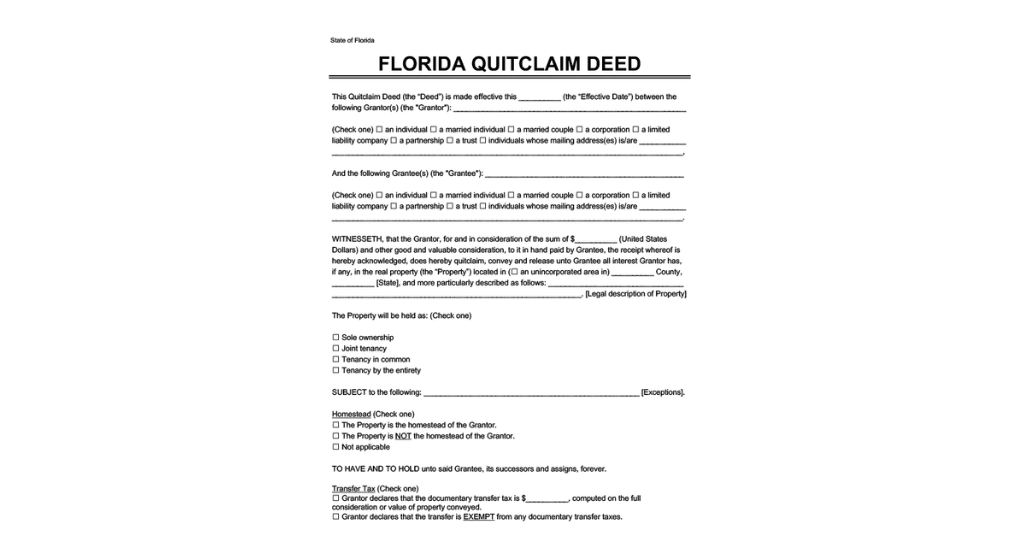
A Quitclaim Deed is used to transfer any ownership interest in the property, often used to resolve title issues. For example, if there is a dispute over property ownership or if a seller is transferring ownership to a spouse, heir, or business partner, a Quitclaim Deed may be necessary. It provides a quick way to clear up any unresolved claims or discrepancies in the property’s title before the sale.
Trust Documents (If Property Held in Trust)
Selling property held in a trust in California requires key documents, such as the Trust Agreement, which outlines the authority to sell, and the Deed of Trust, proving the trust owns the property. Additionally, title documents must confirm the property’s clear title.
Sellers should be aware of potential capital gains tax and property tax reassessment after the sale, though exclusions like Proposition 58 can help avoid reassessment when transferring property to family members.
Death Certificate (If Selling Inherited Property)
If the property is part of an estate sale, a Death Certificate is required to verify the decedent’s passing and confirm that the property is part of the estate. This document is necessary to transfer ownership to the heirs or the executor of the estate, ensuring the sale follows California’s probate laws. Without the Death Certificate, the transaction cannot proceed, as it legally proves the right to sell the property.
Notarized Power of Attorney (If Applicable)
If the seller cannot be present for the transaction, a Notarized Power of Attorney (POA) may be required. This legal document grants another person the authority to act on the seller’s behalf, including signing documents and completing the sale. The POA must be notarized to be valid. It ensures the seller’s interests are protected, even if they are unable to physically attend the closing, allowing the transaction to proceed smoothly.
| Document Name | Required By Law | Applies To | Provided By | Notes |
| Termite Inspection Report | No (Lender May Require) | Older Properties | Seller / Pest Company | Confirms absence of wood-destroying pests |
| Septic/Well Inspection Reports | No (If Applicable) | Rural/Private Systems | Seller | Verifies water quality and sanitation compliance |
| Utility Bills | No | All Sales | Seller | Offers transparency on monthly costs |
| Home Warranty Info | No (If Offered) | Optional | Seller / Warranty Provider | Covers appliances/systems for new owner |
How Do Key Documents Ensure Smooth Transactions in Residential Real Estate Investment?
Key documents, such as the Transfer Disclosure Statement (TDS), Mortgage Payoff Statement, and Deed of Reconveyance, ensure a smooth, transparent, and legally compliant real estate transaction. These documents confirm the property’s condition, financial status, and clear ownership, reducing the risk of disputes or delays. For sellers, working with a residential property investment company can simplify the process further. Such companies assist with handling all necessary paperwork, ensure quick closings, and provide cash offers, helping to eliminate many of the complexities typically associated with selling a home.
